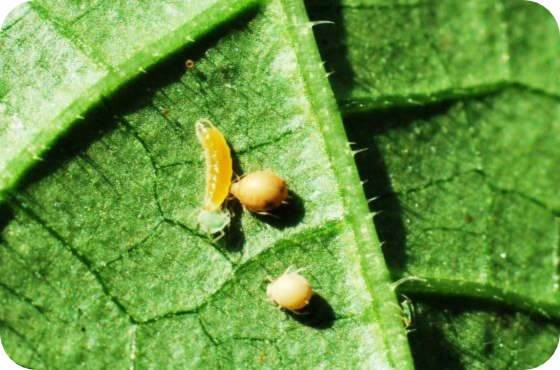Quality Products
Fast Delivery
Premium Service
Written by Kevin van Kester | Last update: 31. December 2020
The gall midge Aphidoletes aphidimyza larvae are effective in controlling over 70 aphid species, including black bean aphid control. Winter presents challenges for effectively using this organic aphid control in Canada due to the cold temperatures and the start of a new cultivation. However, by considering a few key factors and essential tips listed by our specialist, you can enhance the performance of Aphidoletes aphidimyza as organic aphid control in greenhouse environments during the winter months.

At the beginning of a new crop, greenhouses typically have few spiders, which means fewer spider webs are available for Aphidoletes aphidimyza adults to use for mating. Without these webs, mating can be reduced, leading to fewer eggs being laid. To address this and to ensure optimal organic aphid control, you can either introduce spider webs into the area where the Aphidoletes are released or bring in spiders to establish webs within the greenhouse.
Aphidoletes aphidimyza is active at night and sets its eggs at a minimum temperature of 12°C. The higher the temperature the better the egg deposits. During the daytime larvae develop best at a temperature of around 23°C.
When a plant is attacked by aphids it secretes chemical signals that attract natural enemies of the aphid. These signal substances are better dispersed through the greenhouse in warm air. At a lower temperature Aphidoletes has much more difficulty in detecting aphids and locating their prey.
During this time of year, low humidity levels are common due to young, open crops, resulting in fewer dewdrops within the plants. These dewdrops are crucial for Aphidoletes aphidimyza as they rely on them for hydration; without access to moisture, the gall midges can die within hours. To address this, place a damp cloth or a piece of moist floral foam soaked in 10% sugar water near the area where you release the gall midges.
Additionally, maintaining proper air humidity is essential for egg deposition. Aphidoletes aphidimyza tends to favour the lower leaves of plants, where the conditions are more moist and dark, enhancing their chances of successful egg laying.
In many new crops, hygiene measures involve laying foil on the ground, but this practice can negatively impact Aphidoletes aphidimyza development. Since Aphidoletes aphidimyza larvae need to pupate in the soil, placing foil on the ground can prevent them from reaching the soil, leading to their death. While growers may have limited options to address this issue, it's crucial to be aware of its effects. Additionally, the cooler soil temperatures during this season can prolong the pupation process, resulting in a delay in the emergence of new gall midges.
Another crucial factor to consider, aside from weather conditions, is the proper distribution of the material. APHIDOcontrol from Agrobio comes in bottles containing vermiculite as a carrier. Unlike some products where you simply turn the cap and place the bottle in the crop, APHIDOcontrol requires thorough scattering. Failing to do so may result in some gall midges remaining trapped in the vermiculite inside the bottle, preventing them from reaching the crop. Ensuring even dispersion is key to maximizing the effectiveness of this organic aphid control agent.